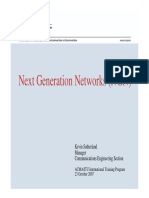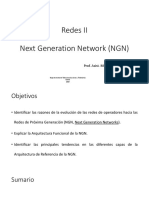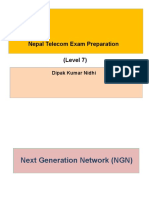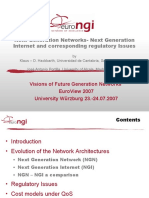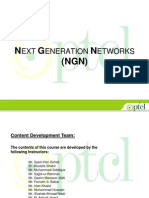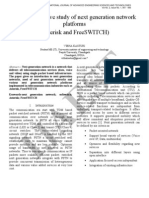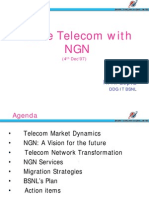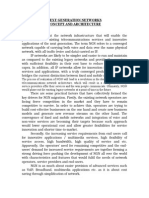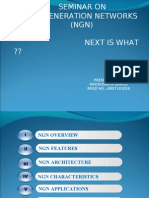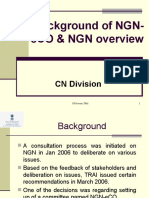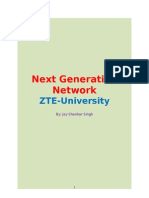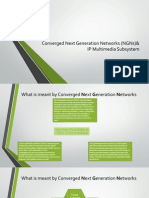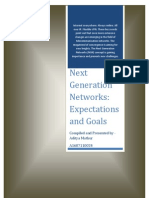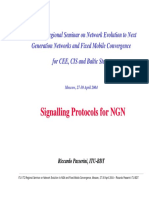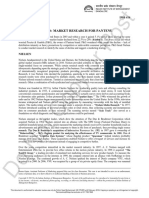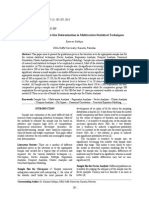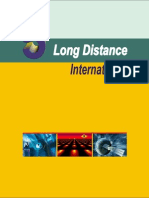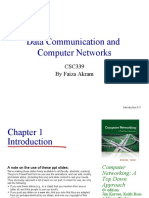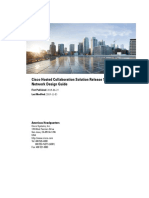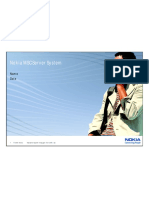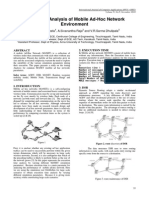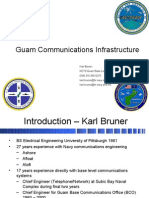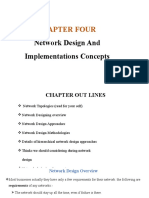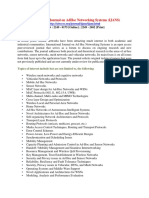Next Generation Networks (NGN)
Kevin Sutherland
Manager
Communications Engineering Section
ACMA/ITU International Training Program
23 October 2007
2
What is NGN?...
A concept for a framework for evolution of network
architecture and capabilities, as defined by ITU-T
Recommendations
ITU-T SERIES Y: GLOBAL INFORMATION
INFRASTRUCTURE, INTERNET PROTOCOL ASPECTS AND
NEXT-GENERATION NETWORKS
Next Generation Networks Frameworks and functional
architecture models
Y.2001 (12/2004) General overview of NGN
Y.2011 (10/2004) General principles and general reference
model for Next Generation Networks
3
NGN Definition from Y.2001
Next Generation Network (NGN):
a packet-based network able to provide telecommunication
services and able to make use of multiple broadband, QoS-
enabled transport technologies and in which service-related
functions are independent from underlying transport-
related technologies.
It enables unfettered access for users to networks and to
competing service providers and/or services of their choice. It
supports generalized mobility which will allow consistent and
ubiquitous provision of services to users.
4
NGN Definition cntd
Practical Description (from ETSI)
The convergence of the public switched telephone
network, the (PSTN) voice network,
the wireless networks (WiFi / WiMAX / GSM / UMTS)
and the data networks (Internet)
and broadcasting networks & services ?...
Convergence in the Dictionary
from the Latin verb convergere, i.e. to incline together
convergence is a coming together of two or more distinct
entities or phenomena
5
Convergence...
Means different things to different people...
Business model convergence
Businesses from telco/broadcasting/media sectors all converging by
aiming to provide similar products and services
Telstra selling movies, Apple selling music, movies
Apple selling phones that play music and movies
Network Convergence
PSTN (fixed) and 2G/3G (mobile) carry voice and data
Fixed and mobile networks are converging (FMC)
Voice, data, video, audio, music, messaging etc. now carried over a
single broadband service
NGN and 4G mobile to be all-IP end-end
Device Convergence
e.g. Mobile phone with camera, music player
6
NGN
DNS
Spam
2G
3G
VoIP
CONVERGENCE
ENUM
Internet
IPv6
IMS
MoLI
IPTV
Video Gaming
QoS
Access
FMC
Spectrum
PSTN
7
NGN applications...
www access (browsing, information, e-commerce...)
voice telephony (VoIP)
video calling
video on demand
broadcast television (IPTV, unicast, multicast)
multimedia messaging
games
?
?
8
All converging into one universal device?
Source:http://www.telstra.com.au/abouttelstra/investor/docs/tls366_stratrevjustinmilne.pdf
Not necessarily
9
Device/Consumer Convergence
Devices from each world having
Similar functions; TV over internet, internet on phones
All able to connect to each other, wirelessly
Source: http://www.dlna.org/about/dlna_white_paper_2006.pdf
10
Existing Telecommunications
Benefits:
Worked well for stand-alone systems
Challenges:
Many Networks =High Operational and Interworking Costs
Slow to introduce new services
Users require different devices for different services
Difficult to integrate new services or technologies
Ser vi c es
Tr anspor t
& Ac c ess
Source: ASTAP05/WS-IP&NGN/13
11
Emerging Telecommunications
Services and access technologies only need to interface to the
common transport layer (IP)
Ac c ess
Tr anspor t
Ser vi c es
Internet Protocol
Benefits:
Rapid Service Deployment =New Service Revenues
Allow continued growth of the network
Flexible architecture for future growth and new technologies
Allows for competition at individual layers
Challenges:
Legacy policy frameworks are challenged by the emerging
telecommunications model throughout the world
Source: ASTAP05/WS-IP&NGN/13
12
Core IP/MPLS Networks
User
One schematic view of NGN
DSL
ASP
Network
WEB
ASP
Network
VoD
DOCSIS
IMS
MMS
GSM Wi-Fi
Access
Transport
Services
SIP
PSTN
PSAP
Network
E911
Source: ASTAP05/WS-IP&NGN/13
13
NGN realisation example
Access
Independent
(Core
Transport)
Network
Service/
Network
Control
Platform
Application
Multi-layer Service Edge
Presence
QoS/Traffic
Control
RADIUS
SIP
Single
Sign-On Server
Accounting
Multi-point
video-conference
Home
Agent
Certification
Authority
NW
defense
HGW
management
ONU
ONU
Service Node
ADSL modem
Core Node
MC WDM
DSLAM
MC
MC
MC
Distribution Function
Business
User
HGW
OLT
V-ONU
HE
V-OLT
Visual
System
Mass User
Other
Network
GW
PSTN
Community Collaboration Community Collaboration Contents Contents Commerce Commerce
Ubiquitous Network
User
Network
Access
Dependent
Network
BS
RMC
MSC
Transport
stratum
Service
stratum
GW
GW
Wireline Access RAN
HE: Head end
MSC: Mobile Switching
Center
RMC: Radio Media
Converter
BS: Base Station
DSLAM: Digital Subscriber
Access Module
OLT: Optical Line Terminal
ONU: Optical Network Unit
MC: Media Converter
NNI
UNI
Source: http://www.itu.int/ITU-T/ngn/ngn.ppt#540,25,Slide 25
14
Driving forces for NGNs
Europe
Ageing networks in need of new equipment
Cost savings, new services
North America
Cost savings, new services, competitiveness
Operators: IP core conversion, fixed-mobile convergence,
new service offerings (VoIP, IPTV)
Asia Pacific Region
Mobile users, less investment in legacy infrastructure, new services,
address space limitations, government NGN initiatives
Role-out of new networks in the countries in economic transition
Source: ASTAP05-FR10-PL-30
15
Short term issues
Numbering
Numbering
Regulation of
Standard Telephone
Service
Regulation of
Standard Telephone
Service
Quality of
Service
Quality of
Service
Next Generation
Longer term issues
Emergency
Emergency
Privacy
Privacy
Security
Security
Competition
Competition
Consumer
awareness
Consumer
awareness
J urisdiction
J urisdiction
Core policy areas:
Consumer issues
Competition
Security
Scope for self-regulation
Policy implications.
Source: ASTAP05_WS.IP&NGN-09
16
Access, security & interoperability
E-mail
SME E-commerce
PSTN,
NGN, 3G
E-banking
E-tax
Office systems
Intranets
E-business,
Managed
networks,
Corporate
networks
SMS
National security
SECURITY
WiFi
WiMAX
IP TV,
PVR
INTEROPERABILITY
ACCESS
Pay TV
spam
Free-to-air &
Satellite b/c
Source: ASTAP05_WS.IP&NGN-09
17
ACCESS INTEROPERABILITY
Consumer
Consumer
Competition
Competition
Security
Security
Emergency
Quality of Service
Rights of redress
Directories
Privacy
Information
Choice
Special needs
Universal service
Convergence
Bundling
Bottlenecks
Interconnection &
access
Carrier selection
Number portability
Migration
Investment
STANDARDS
Critical Infrastructure
Viruses & firewalls
Network attack
Disaster recovery
Lawful Interception
Cybercrime
Misuse
IDENTITY, NUMBERING, ADDRESSING
Source: ASTAP05_WS.IP&NGN-09
18
Areas of interest for NGN standards activity
International Telecommunications Union (ITU-T)
Telecommunication StandardizationAdvisory Group (TSAG)
Study Groups (SG13 lead SG for NGN)
NGN Global Standards Initiative (NGN-GSI), since J an 2006
European Telecommunications Standards Institute (ETSI)
TISPAN, 3GPP / IMS
Internet Engineering Task Force (IETF)
Protocols (IP, SIP, MGCP, ENUM, etc)
Global Standards Collaboration (GSC)
ACIF/CA, ARIB, ATIS, CCSA, ETSI, ISACC, ITU-T, ITU-R, TIA, TTA, TTC
Asia-Pacific Telecommunity(APT)
ATP Standardisation Program (ASTAP), NGN Expert Group
Asia-Pacific Economic Cooperation (APEC) Telecommunications and
Information Working Group APEC TEL
19
Defining Standards
Smaller industry forahave helped shape international standards.
IETF have developed many of the core NGN technologies (IP, MPLS, SIP, etc.)
3GPP integrated IP-based technologies into a building block of the NGN, IP
Multimedia Subsystem (IMS)
Release based (ETSI TISPAN r1, 3GPP r7, ITU NGN r1-3)
ITU involvement is necessary at the international level to define an
Evolutionary Framework to help solve interworking, mobility and
service definitions issues, but
There could be more pro-active cooperation between the telco and
internet stakeholders
20
ITU-T Structural model of Functional components
Transport stratum
Service stratum
Media
Handling
Functions
Access
Functions
Other
networks
Other
networks
Customer
Functions
Transport
User
Profile
Functions
Application Functions
Gateway
Functions
Transport Control
Functions
Control
Media
NNI
UNI
Edge
Functions
Network
Attachment
Control Functions
Core Transport
functions
Core Transport
Functions
Access
Transport
functions
Access
Transport
Functions
Service and Control
Functions
Service
User
Profile
Functions
M
a
n
a
g
e
m
e
n
t
F
u
n
c
t
i
o
n
s
Ref: http://ties.itu.int/u/fgngn/fgngn/readonly/200504_Geneva/focus_group_reports/FGNGN-MR-0040r1.doc
21
Current coverage of FGNGN Release 1
R esource and A dmi ssi on
C ontrol F uncti ons
R A C F
N etwork A ccess
A ttachment F uncti ons
N A A F
Other M ul ti medi a
C omponents
Streami ng Servi ces
A ppl i cati on F uncti ons
C ore transport
F uncti ons
A ccess T ransport
F uncti ons
N G N
T e r m i n a l s
C u s t o m e r
N e t w o r k s
U ser
P rof i l e
F uncti ons
O
t
h
e
r
N
e
t
w
o
r
k
s
L e g a c y
T e r m i n a l s
G W
PST N / I SD N E mul ati on
I P M ul ti medi a
C omponent
N N I
T r a n s p o r t S t r a t u m
S e r v i c e S t r a t u m
U N I
E dge
F uncti ons
A ccess
F uncti ons
Servi ce
and
C ontrol
F uncti ons
C ustomer and
T ermi nal F uncti ons
QoS Aspects and one part of Control aspect
(IP QoS signaling Requirement)
A part of
Release 1 coverage
Ref: http://ties.itu.int/u/fgngn/fgngn/readonly/200504_Geneva/focus_group_reports/FGNGN-MR-0040r1.doc
22
2006 NGN-GSI
Co-located Joint Activity : SG 11, 13, 19 + others
Coverage
Release 2 Services and Capabilities
Functional Architectures and Requirements
Mobility Management and FMC
IPv6 application into NGN
End-to-End QoS
NGN Signaling with Resource Admission Control
Migration and Interworking aspects (inc. IWF)
NGN Security
Home Networking (JCA-HN established March 2005)
Network aspects of Identification systems (inc. RFID)
(JCA-NID established July 2006)
IPTV (IPTV-FG established on April 2006)
Others
Source: http://www.itu.int/ITU-T/ngn/ngn.ppt#485,24,2006 NGN-GSI
23
IP Multimedia Subsystem as defined by 3GPP
3GPP IMS standards define a network domain dedicated to the control
and integration of multimedia services.
IMS is defined by 3GPP from Release 5 onwards (2002)
3GPP2 equivalent of IMS is the MMD (MultiMediaDomain), fully
interoperable with 3GPP IMS
IMS builds on IETF protocols
Based upon SIP, SDP, COPs and Diameter protocols
3GPP have enhanced these IETF protocols for mobility
IMS in short...
Open-systems architecture that supports a range of IP-based services
over the PS domain, employing both wireless and fixed access
technologies
Basis for:My communications services anywhere, any terminal, anytime ?
What is IMS?
24
IMS Architecture
25
ETSI - TISPAN
TISPAN in an ETSI technical committee,
dealing with fixed networks
and the migration from circuit switched networks to
packet-based networks (Telecoms & Internet converged
Services & Protocols for Advanced Networks (TISPAN)
TISPAN also deals with service aspects,
architectural aspects, protocol aspects, QoSstudies,
security related studies, mobility aspectswithin fixed
networks, using existing and emerging technologies.
TISPAN outcomes much-anticipated - basis for
international standards & specifications for FMC
26
Communications Systems Layers
Source: Solum, L & Chung, M The Layers Principle: Internet Architecture and the Law, June 2003
Logical/Code
Layer
Physical Layer
Content Layer
Application/ Services
Application Protocol Layer
Transport Layer
Network Layer
Link Layer
Text, Speech, Music, Pictures, Video,
etc
Web Browsers, Email Client
Programs, MP3 Ripping Software,
Word Processors, VoIP Clients, etc
HTTP, SMTP, FTP, SIP, H323, DNS
TCP, UDP
IP, ICMP, IGMP
Interface to Physical Layer
Ethernet, Modem, DSK, Cable, E1,
Fibre Optics, Satellite, Bluetooth,
Spectrum, etc.
TCP/IP
layers
27
Quality of Service (QoS)
Communications Alliance has established two
working committees to address QoSissues:
IP Network Quality of Service
Voice over IP (VoIP) Quality of Service
Both committees were established in December 2006
by the overarching Communications Alliance VoIP
Working Group
28
Bearer and teleservice QoS
Source: ITU-T Recommendation Y.1542Framework for achieving end-to-end IP performance objectives
29
IP Network Quality of Service working
committee
Developing a guideline for Carriage Service Providers (CSPs)
(including ISPs) on Network IP QoS. The guideline will:
Define a default set of Network IP QoSclasses
Address performance levels for IP packet delay, jitter and loss
Address IP packet prioritisation for implementing the Network IP QoS
classes (eg. through the use of packet marking and handling)
Related test documents will also be developed to verify the
relevant network IP QoSparameters in the guideline
Indicative timeframe for publication is Q4 2007
30
Voice over IP Quality of Service working
committee
Developing a guideline for Australian VoIP Service Providers
and end-users. The guideline will:
Provide a measure of VoIP quality in a usable format for end-users (eg.
a rating based on the ETSI E-model)
Consider Network IP QoSservice classes and requirements
Consider interworkingwith existing voice networks (eg. PSTN/ISDN)
Consider standards and requirements for VoIP CE QoS
Related test documents will also be developed to verify the
relevant VoIP QoSparameters in the guideline
Indicative timeframe for publication is Q4 2007
31
Home Networking standards development
due to the evolution of digital technology (e.g. PCs, media
coding, storage, Internet), home networks have evolved
towards a complex set of devices supporting services and
applications in the home-based business, information,
entertainment and security/control areas
various standards bodies & consumer electronics
manufactures are developing standards for Home
Networkingapplications in this converged environment
Home Networks have a role in Next Generation Networking
standards bodies have resolved to collaborate and promote
the development of harmonized Home Networking standards
and related networking standards.
32
NGN Consumer Access
Multiple Broadband Access Options
xDSL
Ethernet
Home Shopping
Eth. DTV Tuner
Second Line
VoIP
Residential
Gateway
Live Content
Video on Demand
Games Console
Notebook Notebook
PDA PDA
B
r
o
a
d
b
a
n
d
A
c
c
e
s
s
Cable
Home
Security
Fiber
802.11b/g
Router
Set-top Box/DVR/PVR
E
t
h
e
r
n
e
t
33
Home Networking
Devices from each world:
All able to connect to each other, wirelessly
Exchanging and sharing content
Source: http://www.dlna.org/about/dlna_white_paper_2006.pdf
34
NGN Competition issues
Market power and network effects
implications for existing and future customer access
services
any-to-any connectivity
Interconnect
charging models for multiple providers in an E2E service
pricing
standards
Australian Competition and Consumer Commission
(ACCC) has begun canvassing some of the issues in
discussions with stakeholders and public.
35
Longer-term NGN issues
implications for competition policy
jurisdiction and extraterritoriality
privacy and security
digital rights management
access and interoperability
common standards
consumer interests
international and domestic governance issues
scope for industry self-regulation
36
Links
ACMA http://www.acma.gov.au
ACCC http://www.accc.gov.au
Communications Alliance http://www.commsalliance.com.au/
DCITA http://www.dcita.gov.au
ITU-T NGN GSI http://www.itu.int/ITU-T/ngn/index.phtml
ETSI TISPAN
http://portal.etsi.org/portal_common/home.asp?tbkey1=TISPA
N
IETF http://www.ietf.org/
APT/ASTAP
http://www.aptsec.org/Program/ASTAP/EG/NGN/index.htm
GSC http://www.gsc.etsi.org/
37
In closing
NGN is a concept, not just a technology.
NGN is an attempt by operators to provide a single technology
platform into the future to support converged services
NGN is a global initiative, coordinated by the ITU-T
Robust and open standards are essential to the long term
success of IMS and NGN
Not everyone likes or agrees with the NGN concept
especially large parts of the internet community
Regulators will have an interesting time trying to manage what
is likely to become a standards/systems battle between various
players
38
Thank you for your attention
Questions ?...
